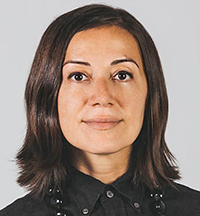
Selin Olmsted
THE DESIRE TO help others look their best developed early for Selin Olmsted; as a child in Turkey she drew stick-figure clothing collections for her mom. Later, the Fashion Institute of Technology grad created menswear for labels in New York before moving into eyewear design, spending several years at Warby Parker. She struck out on her own in 2015 and set up the Selin Olmsted Design Studio in NYC, which is now in its sixth year of providing independent design and product development services for the likes of Raen, Article One and Oscar de la Renta. Olmsted shares her experience of creating the studio and her thoughts on the design process and current eyewear trends, among other topics.
THE IDEA
While at Warby Parker, it dawned on Olmsted just how few designers there are in the U.S. with the training, knowledge and experience to create and develop new eyewear styles. “It’s shocking, but there is no fashion or design school teaching eyewear design of any kind, even though it’s a multi-billion-dollar industry. You have to sort of fall into it from somewhere else.” Conversations with key figures in the industry convinced her of the need for an independent studio. “The industry is starving for designers, especially in the U.S.,” says Olmsted. “When that thought hit me, I decided to start a small eyewear studio.”
Advertisement
THE EXECUTION
The first step was meeting prospective clients and gauging the need for the type of business she had in mind. Convinced she was on the right track, she spent three or four months setting up the company, redoing her portfolio, creating a website and focusing on business development. “Receiving my first project brought me joy and confidence,” she recalls. Before long, brands were contacting her about projects, allowing her to hire a small team.
With those first clients, Olmsted’s goal was “to basically overdeliver on every project and make myself indispensable, which my team and I still try to do to this day.” Her basic process starts with getting to know the client and their brand, their specific goals and the intended market. “To get to know and learn about the brand’s customers is crucial.”

Team
Working with diverse brands requires flexibility, but Olmsted is able to pitch a stylistic departure — albeit of varying degrees — to almost all clients. She sees current eyewear trends as polarized, with an appetite for “feather-like, super thin, lightweight materials” coexisting with “statement silhouettes, more weight, more rim height, more 3D effect and volume.” She is also determined to ensure the industry embraces sustainability as more than a fad.
This year, the studio has tried out a new business model, offering full-package services including not only design and product development, but also sourcing, production, packaging and importing. “This was a great experience. We did an introductory batch to test ourselves … and are very happy how the project turned out.”
Advertisement
THE REWARDS
There are many things Olmsted loves about what she does; not least is simply having the opportunity to meet so many inspiring people: “Not only amazing creatives who have a different perspective on things, but also gifted, talented, intelligent and kind folks, entrepreneurs, professionals and people with new ideas.” She also finds it personally rewarding to have created a work environment in which others can feel fulfilled. And in difficult times, she’s grateful to be able to help the companies and teams she admires, as well as donating frames to essential workers and people in need.
PHOTO GALLERY (12 IMAGES)
Do It Yourself: Thoughts on Eyewear Design From Selin Olmsted
- STEP BY STEP. “While learning eyewear design, invest time in learning the various steps of eyewear craftsmanship … If not beautifully crafted, a good design is useless.”
- CUSTOMER FIRST. Remember that the customer, while not an expert, will always have an idea of what styles suit them. “Think outside of the box … while knowing what [they’re] comfortable wearing.”
- STAY RELEVANT. Exploring new perspectives is wonderful, while being mindful of technical feasibility. “Trends change in eyewear. They evolve. An open mind for change is one of the paths to relevance.”
- BE SUSTAINABLE. Olmsted urges ECPs to seek environmentally aware biz ideas. For an optician, for example, bringing customers’ disused eyewear back to life could be a great, and creative, business model.
- FIND THE NEED. If you plan to launch an eyewear brand, tackle an unexplored niche or price category, or solve a problem in the industry. “I do not recommend you launch a brand in an over-explored, crowded segment of the industry.”